We’d like to remind Forumites to please avoid political debate on the Forum.
This is to keep it a safe and useful space for MoneySaving discussions. Threads that are – or become – political in nature may be removed in line with the Forum’s rules. Thank you for your understanding.
📨 Have you signed up to the Forum's new Email Digest yet? Get a selection of trending threads sent straight to your inbox daily, weekly or monthly!
Options for Smart Timers/Switches for Immersion Heaters & Storage Heaters (potential IFTTT)?
Comments
-
I would guess that the issue is cost, although solid state relays are not particularly expensive.Reed0
-
Isn't that a contradiction?Reed_Richards said:I would guess that the issue is cost, although solid state relays are not particularly expensive.
I would much prefer a solid state solution but don't feel comfortable using them (there is something more reassuring about an air gap than a high resistance semiconductor junction).
Scrounger0 -
I don't think it's a contradiction. A consumer product want's to be as cheap as possible to be competitive so if you can get an air gap switch for £10 less than a solid state version that would be significant (but I haven't priced either so I don't know if it is true). Personally, I am vastly more reassured by a semiconductor junction than by anything that involves moving parts and randomly sequenced switching.Scrounger said:
Isn't that a contradiction?Reed_Richards said:I would guess that the issue is cost, although solid state relays are not particularly expensive.
I would much prefer a solid state solution but don't feel comfortable using them (there is something more reassuring about an air gap than a high resistance semiconductor junction).
ScroungerReed0 -
@ch_152 as requested...
@Scrounger I don't suppose you'd be able to send me a photo of how it's connected up inside the enclosure and then this might make sense to me. I actually have a bunch of Tapo smart plugs knocking about.
Cheers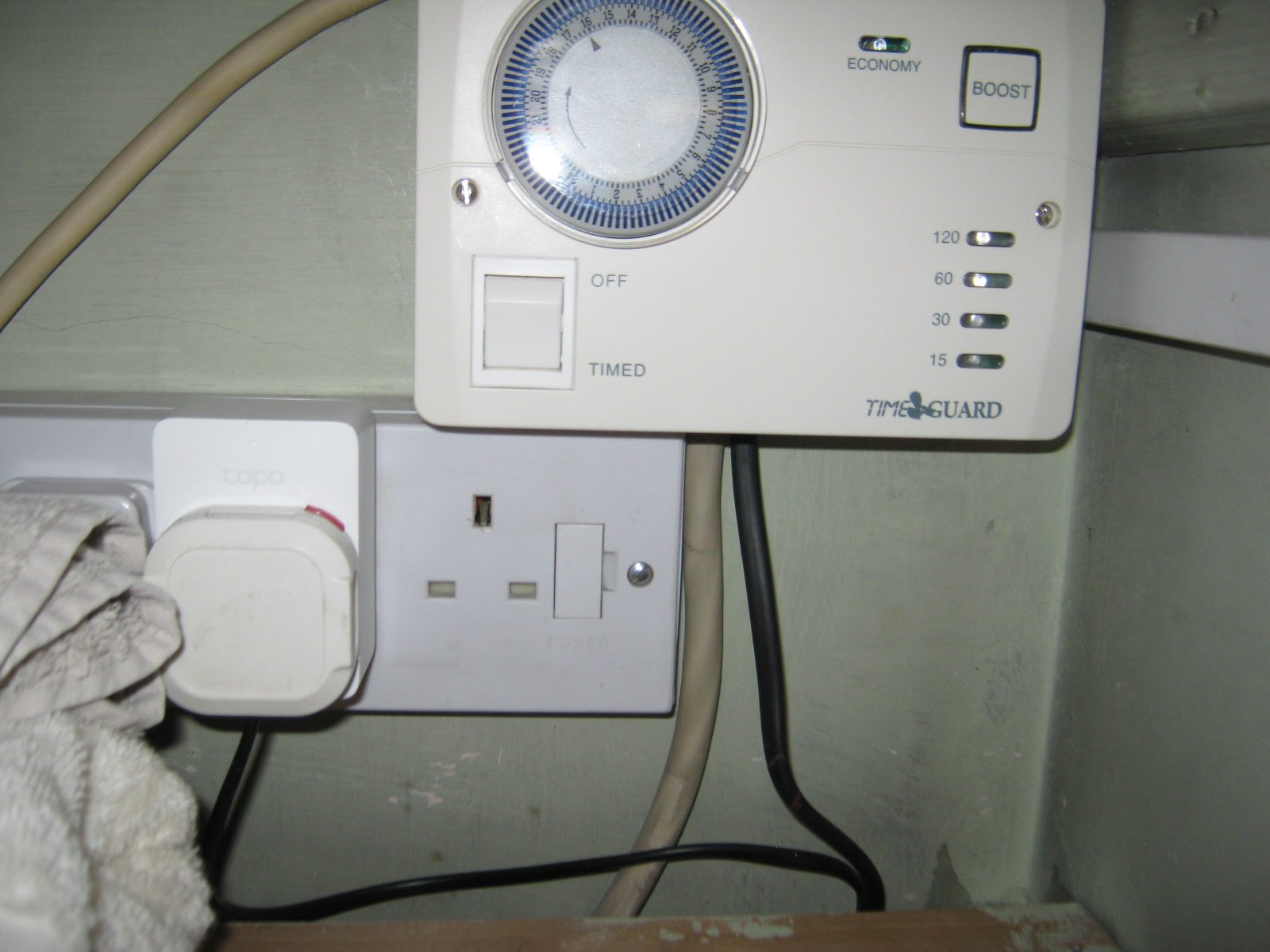
The two black cables go down to the contactor.
All the interconnections are done within the Timeguard TRTM7 controller.
The Tapo is on the ring main, Timeguard, & immersion on a dedicated 16A radial supply.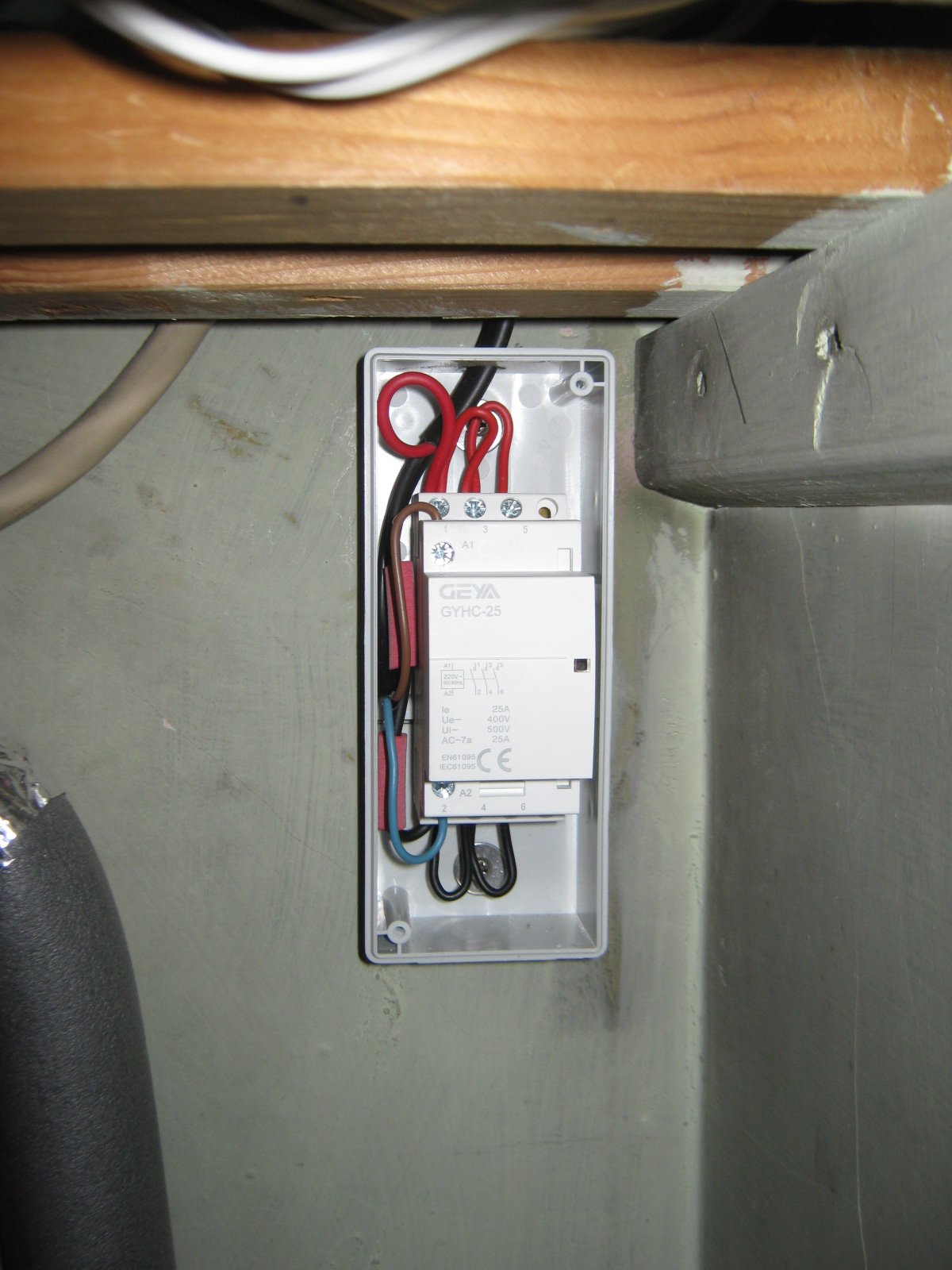
Thin Brown and Blue wires are from the Tapo smart switch
Thick Red and Black (+pink sleeve) are doing the switching - live only, the 3 poles of the contactor are wired in parallel.
Below is a portable contraption I made to (safely) switch loads up to 13A with a Tapo.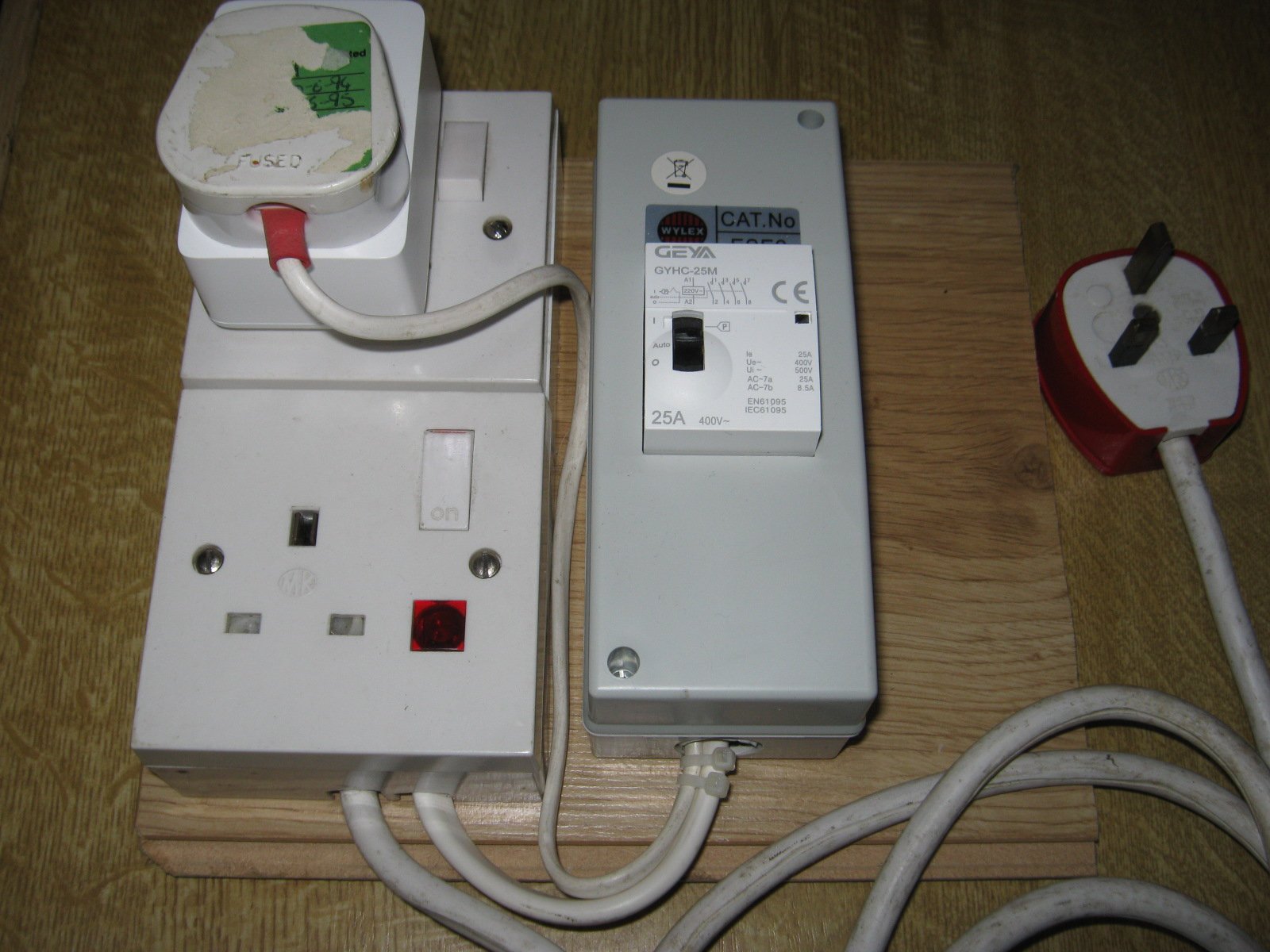
This is a portable contraption I made to switch loads up to 13A with a Tapo. The 4-pole contactor has a manual override.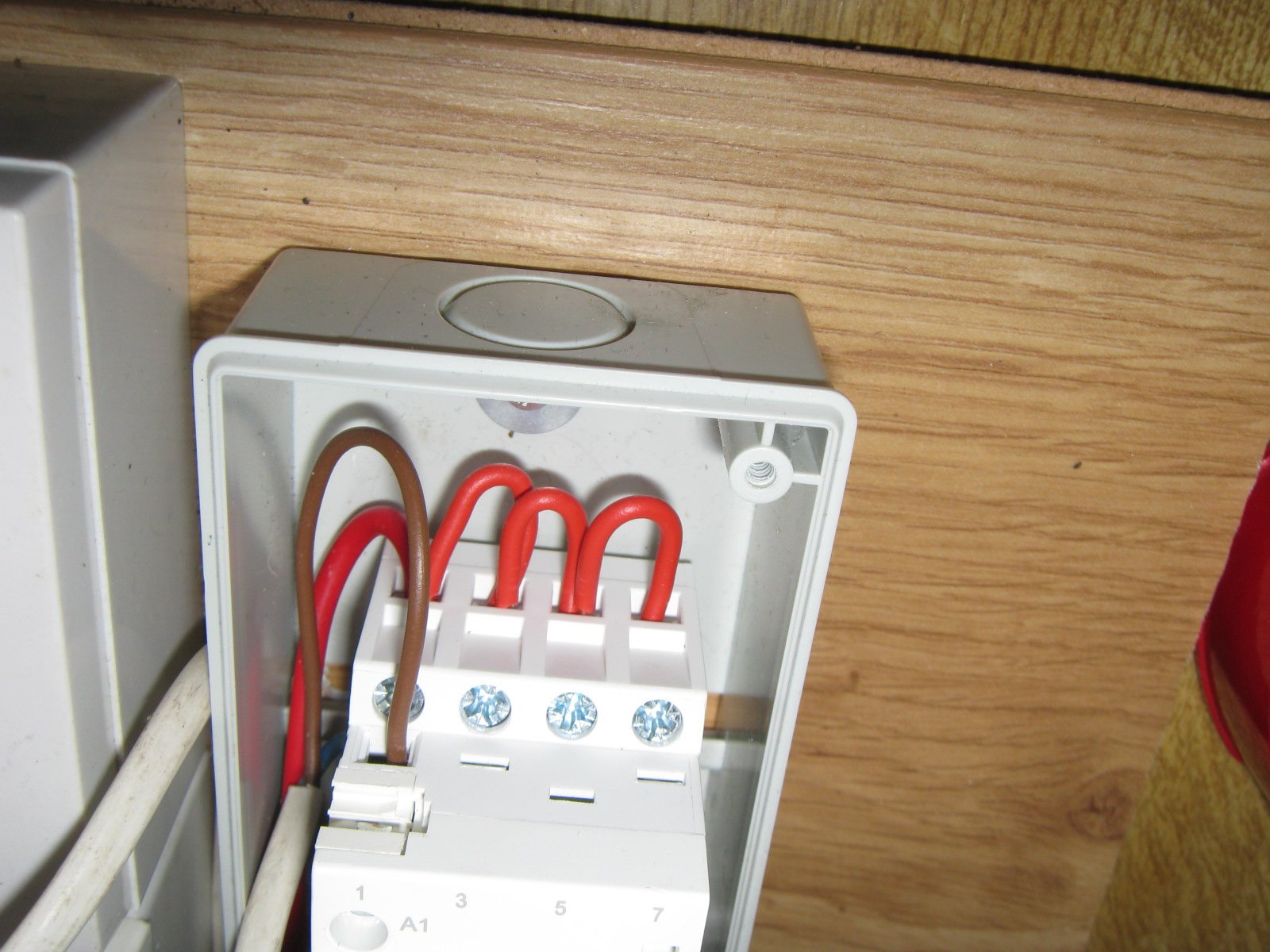
4-poles connected in parallel.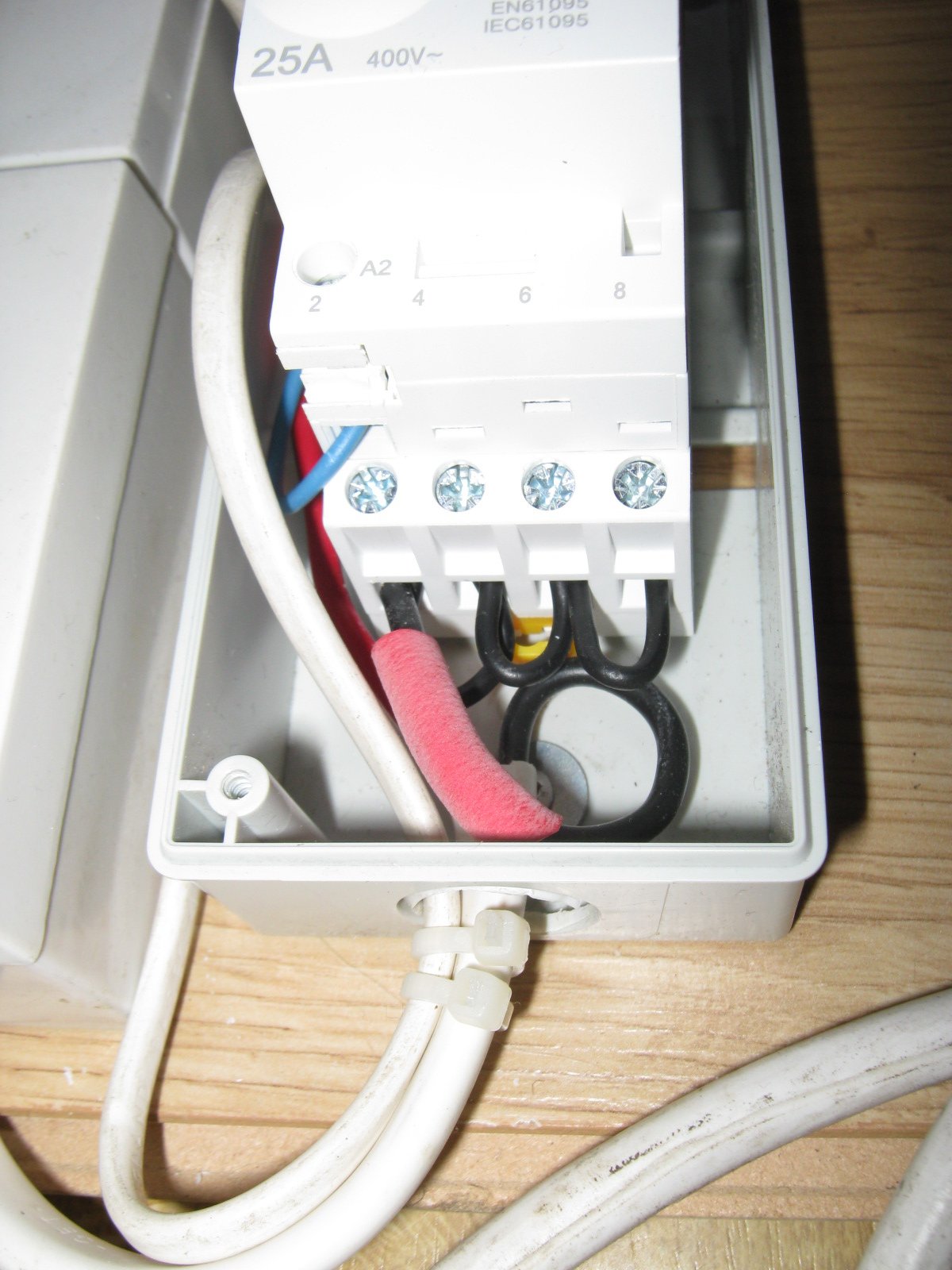
Again the Tapo control wires are brown and blue.
Switch wires are red and black (+pink sleeve), again live switching only.
Scrounger
1 -
I have a 5-port smart meter. I had intended on changing my old night storage heater to a newer one with a daytime boost function and built-in timers. As such, I got an electrician to wire up so that the supply to the "off peak" consumer unit bypasses the E7 timer/contactor etc. and is always on.Scot_39 said:The contactor can essentially be a "dumb unit" - you supply a low voltage / low ampage switch signal from a timer - it switches the full load.If your on E7 at the moment - with a current smart meter or a digital meter - that could be a 5 port meter - it has the timer (intelligence) - and the normally 100A contactor (live restricted output wire switch) built in.Or you could be as some here would put it less lucky - and have a four port meter - with built in timer - driving a control singal on a very low amp output - to a contactor. And the contactor switches the 100A restricted consumer unit tail.This user has a 4 port set-up - with a similar (same) Proteus contactor module as my install - switching his restricted time supply consumer unit live tail - the RHS block - LL in (from meter via Henley) live 24/7 - LLL out - restricted time only
I didn't have the time or ££ to get a new NSH, so I'm looking for a relatively in-line way to control the existing one for this winter!
0 -
@Scrounger absolute saint, thank you so much - this makes a lot more sense now. And the portable jig is a smart idea!
@FreeBear still a little confused over the scenario where there's only one "supply". I probably will get an electrician in to sort this, but for my curiousity...
In Scrounger's example the Tapo is powered off a separate supply (just off the normal ring main). And that switch provides the voltage to tell the relay in the contactor to switch.
If you only have a single supply (let's say a single T&E running up to an immersion heater), how do you wire it? Would that essentially be split and run the Shelly/Sonoff off that same supply (in "parallel" to a certain extent) that also goes to the contactor? That doesn't quite make sense to me.
Googling things like "Shelly relay control contactor" comes up with surprisingly few useful results...
0 -
ch_152 said: If you only have a single supply (let's say a single T&E running up to an immersion heater), how do you wire it? Would that essentially be split and run the Shelly/Sonoff off that same supply (in "parallel" to a certain extent) that also goes to the contactor? That doesn't quite make sense to me.Yes. You would have the single T+E feeding both the contactor an the Shelly. The switched output from the Shelly would go to the coil on the contactor, and the load wired to the contactor. If you were to use a contactor similar the one used by @Scrounger, fit it inside a slightly larger box so that the Shelly could sit next to it. All the wiring would then be enclosed in a nice rigid box. Ideally, you'd want to use proper strain relief glands where the cables come in & out.Found a post about wiring a Shelly (or any other smart switch) to a contactor - https://community.home-assistant.io/t/high-current-20amp-smart-switch/138701/20Also see that Shelly do a 3-phase DIN mounted smart relay rated at 16A per phase (48A if all three are wired in parallel). Not cheap at £72, but worth a look - https://shellystore.co.uk/product/shelly-pro-3/Or a 4 channel with power monitoring for £100 (16A per contact for a total of 64A) - https://shellystore.co.uk/product/shelly-pro-4pm/
Any language construct that forces such insanity in this case should be abandoned without regrets. –
Erik Aronesty, 2014
Treasure the moments that you have. Savour them for as long as you can for they will never come back again.1 -
I'm really pleased with my improved immersion heater setup with additional Tapo control. I'm on Octopus Agile for electricity and it means that I can heat the water on the cheapest energy slots anytime, even in the middle of the night. Plus I can run hot water cylinder 'legionella cycles' on any Agile -ve price slots even when I'm away from home and the water then usually cold.
Prior, the Timeguard controller was very good by itself (but not particularly reliable IME, and the digital version TRTD7 even worse) but, as @Freebear mentioned earlier, it would be better driving a contactor for the heavy switching. Sadly there is not enough room within the controller casing to fit one internally.
And, of course, the Timeguard by itself didn't suit Agile very well with its daily varying time slots of cheap power.
If I was starting from scratch I'd just use the Tapo with a 2 or 4 pole contactor (>25A rated) but would probably switch both live and neutral lines to the immersion for improved electrical isolation (useful in a fault condition eg immersion element developing leakage neutral to earth).
Scrounger
0 -
Scrounger said: If I was starting from scratch I'd just use the Tapo with a 2 or 4 pole contactor (>25A rated) but would probably switch both live and neutral lines to the immersion for improved electrical isolation (useful in a fault condition eg immersion element developing leakage neutral to earth).In the event of leakage to earth, I would hope that the RCD would trip in the consumer unit. I'd also expect to see a double pole isolation switch on the spur feeding the immersion heater.Any language construct that forces such insanity in this case should be abandoned without regrets. –
Erik Aronesty, 2014
Treasure the moments that you have. Savour them for as long as you can for they will never come back again.0 -
FreeBear said:Bendo said: Seen many reports of burnt out shelly and sonoff relays that despite claiming to be rated at 20A, have clearly failed someway betore.I've got a bunch of Chinese made smart switches that contain 10A relays - Would never, ever trust them to switch that sort of current. Maybe 4-5A max.Also have a couple of Sonoff Basics (rated at 10A), again, I would only trust them up to 4-5A. That aside, I do like the Sonoff products as they are easy to hack and can be flashed with alternative firmware. Tuya based products, another story, so I avoid them like the plaque.The Sonoff POWR320D is rated at 20A, which is probably the maximum rating of the relay. Being conservative, I'd be reluctant to switch more than 10-12A with one. Unless you need the current monitoring abilities of the POWR320D, I'd go for a basic Shelly or Sonoff to switch a suitably rated contactor.I've been using a number of Sonoff POWR320D for switching heaters and immersion heaters for a year or so. One of the immersion heater Sonoffs has just failed so I can confirm from firat hand experience that these are rated in "Chinese amps" which can be somewhat lower than our UK amps
 Rather than wait for the others to burn out, I'm currently in the process of using them to switch contactors. Note that as the immersion heater relay started to fail it created a fair bit of electrical noise as the relay contacts bounced which would take down my wifi occasionally, a considerable annoyance when your heating depends on it.So, on the basis of my (limited!) experience I'd certainly agree with the approach advocated in this thread.One thing that I think does merit a bit more consideration is the safety aspects of this. I've nothing against DIY electrical work and IMHO some people tend to go a bit overboard on this so it's not my intention to start lecturing anyone, particularly as I do a fair bit of electrical work myself where the law allows. Having said that, the plain simple fact is that a large proportion of house fires (maybe even most of them?) are caused by electrical faults.These are high current devices which are more likely to burn out - if you focus on the word "burn" here I don't think I need to say any more. To make matters worse, these things work when you're away from the house or tucked up in bed, so you're not necessarily going to be about to switch everything off and investigate when you pick up the burning smell - again enough said.Although AFAIK nobody is advocating doing anything against the law here I think it's fair to say (and hopefully most here would agree with) that if you DIY this you'll be working at the more dangerous end of what you're allowed to do and need to have this firmly in mind and be honest with yourself about your own competence in this area.One final comment on the safety aspects of this, and the difference between a DIY and a professional job. A properly qualified electrician would often test their work with a MFT or similar tester. In some cases, the testing is done to tick boxes because the rules require it. In other cases a good electrician would do the tests even if not required by law because - well, see above. Which leads to the question of what exactly they are testing? So this is an area where us DIYers need to be honest with outselves. Do you know exactly what a professional electrician tests, how it is done and why? If you don't and go ahead with the DIY work anyway you're taking an unknown risk. Lots of really good YouTube videos on electrical testing if anyone's interested.......1
Rather than wait for the others to burn out, I'm currently in the process of using them to switch contactors. Note that as the immersion heater relay started to fail it created a fair bit of electrical noise as the relay contacts bounced which would take down my wifi occasionally, a considerable annoyance when your heating depends on it.So, on the basis of my (limited!) experience I'd certainly agree with the approach advocated in this thread.One thing that I think does merit a bit more consideration is the safety aspects of this. I've nothing against DIY electrical work and IMHO some people tend to go a bit overboard on this so it's not my intention to start lecturing anyone, particularly as I do a fair bit of electrical work myself where the law allows. Having said that, the plain simple fact is that a large proportion of house fires (maybe even most of them?) are caused by electrical faults.These are high current devices which are more likely to burn out - if you focus on the word "burn" here I don't think I need to say any more. To make matters worse, these things work when you're away from the house or tucked up in bed, so you're not necessarily going to be about to switch everything off and investigate when you pick up the burning smell - again enough said.Although AFAIK nobody is advocating doing anything against the law here I think it's fair to say (and hopefully most here would agree with) that if you DIY this you'll be working at the more dangerous end of what you're allowed to do and need to have this firmly in mind and be honest with yourself about your own competence in this area.One final comment on the safety aspects of this, and the difference between a DIY and a professional job. A properly qualified electrician would often test their work with a MFT or similar tester. In some cases, the testing is done to tick boxes because the rules require it. In other cases a good electrician would do the tests even if not required by law because - well, see above. Which leads to the question of what exactly they are testing? So this is an area where us DIYers need to be honest with outselves. Do you know exactly what a professional electrician tests, how it is done and why? If you don't and go ahead with the DIY work anyway you're taking an unknown risk. Lots of really good YouTube videos on electrical testing if anyone's interested.......1
Confirm your email address to Create Threads and Reply

Categories
- All Categories
- 352.9K Banking & Borrowing
- 253.9K Reduce Debt & Boost Income
- 454.7K Spending & Discounts
- 246K Work, Benefits & Business
- 602K Mortgages, Homes & Bills
- 177.8K Life & Family
- 259.9K Travel & Transport
- 1.5M Hobbies & Leisure
- 16K Discuss & Feedback
- 37.7K Read-Only Boards






